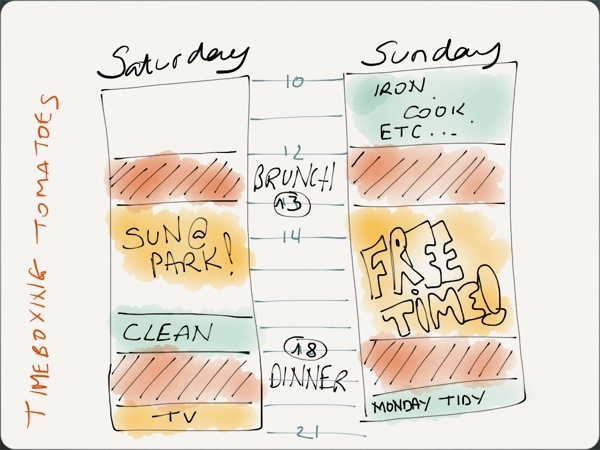timeboxing tomatoes
The pomodoro “italian for tomato” technique had me giggling for a bit, before I read on – thank you wikipedia :Pomodoro technique – and found out it was a desperate student cramming for exams who decided to focus his attention using a tomato-shaped kitchen timer. “Let the first stone be cast…”. So we’ve all used strange techniques for focusing our attention and getting things done, such as remembering to bring home the specific cheese grandmother asked us for, on the day she wanted it. Or, you know, finishing that 15-exercise weekly assignment on time, and writing that 5-page paper in the same week. Things need to get done, and to get them done, one needs to organise them. Let’s look at how.
GTD loves timeboxing
This whole thing started with work, of course. I need to keep better track of who I need to update with progress, who I need to chase down, and generally be sure about what it is that I need to be doing next. My favourite method for getting things done is the eponymous Getting Things Done (GTD) invented by David Allen. I have several lists where my “in-tray” resides, and enjoy keeping them tidy and crossing things off. Then, one day, I read this article, and I could’ve sworn I heard a “click” in my head. A todo list can be a block of time! (“no, really?”, you’ll say. “Better late than never”, I’ll say)
Read the article here: Timeboxing and GTD (Getting Things Done).
This led me to exploring timeboxing a bit further, and mostly remembering when and where I’ve used it in the past.
software engineers timebox too
timeboxing in software engineering. It happens. We’re guilty of it. Frankly, it’s the only way to make sure the project manager doesn’t blow a fuse. So we break down tasks as far as we can see them going, and assign timeframes and dependencies to them. Happily, we each have at most two or three projects we’re working on, so things are tidy.
The truth is that in software engineering, there are three variables: Scope, time, and quality. If time is fixed (which it is), this forces one to focus on scope and quality, and prioritise tasks. Each “box” has start date, end date, deliverable, criteria for success, and so on. This helps focus effort, and showcase time spent on one task more than on others. Also, if we assume quality has to be “zero defects”, and time is fixed, then timeboxing basically forces the hand of anyone wanting to add requests to the only variable dimension: scope. Project managers adore it!
we can clean the flat _and_ go to the park: why timeboxing weekends is good
As in. I really and truly do timebox my weekends. In fact, I should get back into it, as it helps me feel much more accomplished come Monday morning.
I still remember one time, when my ex was stressed that we would not clean the flat if we went to the park first. Given that it was a sunny summer’s day, a scarce resource in the UK, I rebelled, and ran to get pen and paper. I then drew out two columns for the two weekend days, marked off wake-up and bedtimes, shadowed brunch and dinner times, and asked him “how long do we need to clean the flat?”, “three hours”, which I blocked out somewhere between “it’s getting cold” and “dinner time”. I guided him through the rest of the weekend, adding some contingency time in between “tasks”, and a good three hours at the park in the morning.
By the time I was done, it was easy to see that we had hours upon hours of free time to spend at the park, to read a book, to get groceries, or do whatever we pleased, as long as we stuck to doing the chores in their allotted timeboxes (when it’s dark, cold, and we don’t have food coma).
I’d recommend timeboxing weekends to anyone. Using a kitchen timer might be overkill though…



One thought on “timeboxing tomatoes – or what is timeboxing and why is it good?”